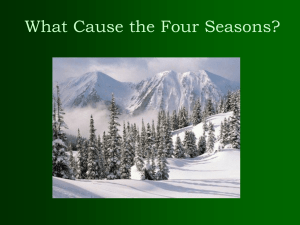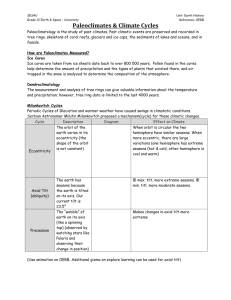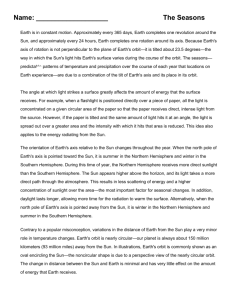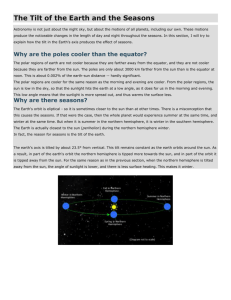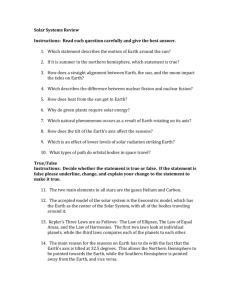The Milankovitch Theory—Earth`s Climate through Time
advertisement
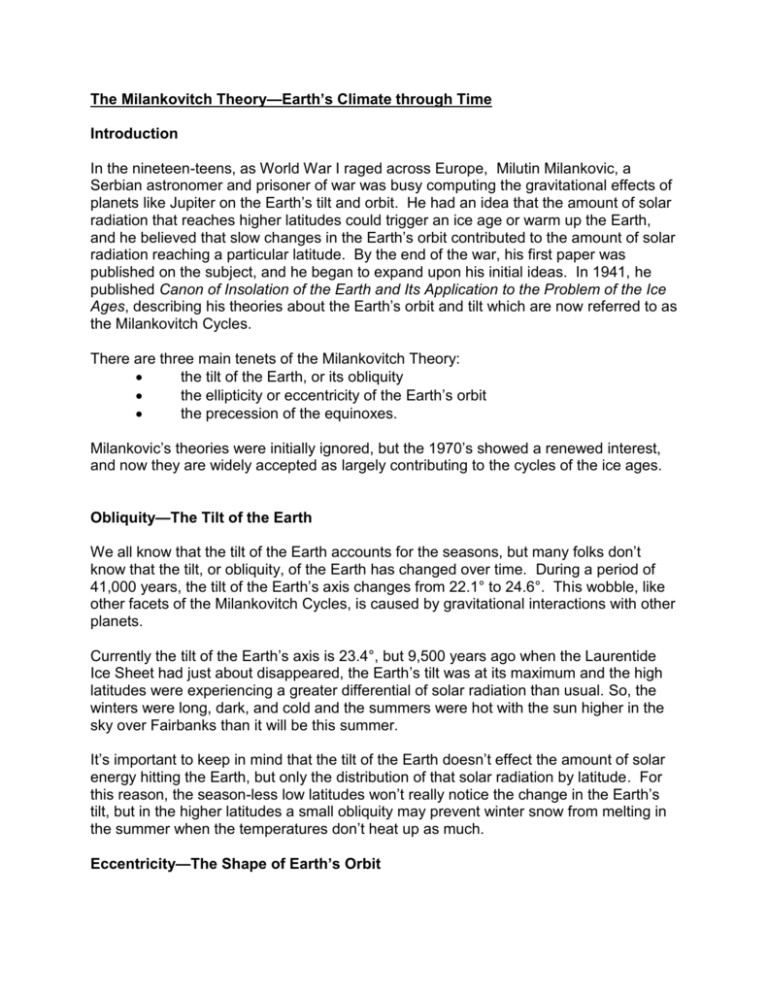
The Milankovitch Theory—Earth’s Climate through Time Introduction In the nineteen-teens, as World War I raged across Europe, Milutin Milankovic, a Serbian astronomer and prisoner of war was busy computing the gravitational effects of planets like Jupiter on the Earth’s tilt and orbit. He had an idea that the amount of solar radiation that reaches higher latitudes could trigger an ice age or warm up the Earth, and he believed that slow changes in the Earth’s orbit contributed to the amount of solar radiation reaching a particular latitude. By the end of the war, his first paper was published on the subject, and he began to expand upon his initial ideas. In 1941, he published Canon of Insolation of the Earth and Its Application to the Problem of the Ice Ages, describing his theories about the Earth’s orbit and tilt which are now referred to as the Milankovitch Cycles. There are three main tenets of the Milankovitch Theory: the tilt of the Earth, or its obliquity the ellipticity or eccentricity of the Earth’s orbit the precession of the equinoxes. Milankovic’s theories were initially ignored, but the 1970’s showed a renewed interest, and now they are widely accepted as largely contributing to the cycles of the ice ages. Obliquity—The Tilt of the Earth We all know that the tilt of the Earth accounts for the seasons, but many folks don’t know that the tilt, or obliquity, of the Earth has changed over time. During a period of 41,000 years, the tilt of the Earth’s axis changes from 22.1° to 24.6°. This wobble, like other facets of the Milankovitch Cycles, is caused by gravitational interactions with other planets. Currently the tilt of the Earth’s axis is 23.4°, but 9,500 years ago when the Laurentide Ice Sheet had just about disappeared, the Earth’s tilt was at its maximum and the high latitudes were experiencing a greater differential of solar radiation than usual. So, the winters were long, dark, and cold and the summers were hot with the sun higher in the sky over Fairbanks than it will be this summer. It’s important to keep in mind that the tilt of the Earth doesn’t effect the amount of solar energy hitting the Earth, but only the distribution of that solar radiation by latitude. For this reason, the season-less low latitudes won’t really notice the change in the Earth’s tilt, but in the higher latitudes a small obliquity may prevent winter snow from melting in the summer when the temperatures don’t heat up as much. Eccentricity—The Shape of Earth’s Orbit The eccentricity is simply how elliptical the Earth’s orbit around the sun is. Mathematically, it can be described as e = √r12 – r22 r2 The gravitational force exerted by Jupiter causes the Earth’s orbit to vary from nearly circular with an eccentricity of 0.005 to quite elliptical with an eccentricity of 0.06. Currently, we enjoy an eccentricity of 0.0174, nearly its minimum. There is only a 3% difference in the distance to the sun at perihelion and aphelion. When eccentricity is maximized, there is almost a 12% difference. Eccentricity has two periods, one of 100,000 years that corresponds with the twenty glacial-interglacial cycles seen in Pleistocene sediments, and one of 400,000 years. When the Earth’s orbit is highly elliptical, one hemisphere basks in very hot summers and freezes in very cold winters while the other hemisphere experiences cool summers and warm winters. Since the sun emits radiation in all directions, Lowrie (1997) explains that “At a distance r [the sun] floods a sphere with surface area of 4πr2. Thus, solar insolation decreases as the inverse square of the distance.” Because of this there can be up to a 30% difference in the amount of solar radiation the Earth receives between perihelion and aphelion. Precession—When is Equinox or Why the Earth’s Orbit is a Daisy The third aspect of the Milankovitch Cycles is the precession of the equinoxes, which refers to perihelion moving later in the year. In 1250, perihelion coincided with the winter solstice (the point in time when the northern hemisphere tilts directly away from the Earth). Since then perihelion has been moving, causing the seasons to shift forward. Now perihelion occurs twelve days after solstice, which means that the Earth is closest to the sun twelve days after its pole tilts directly away from the sun. Over a period of 19,000 to 23,000 years (it varies because the gravitational force of Jupiter distorts the expected period of 25,780 years), perihelion will move from December 21 all the way around back to December 21. Evidence of this change can actually be noticeable over the life of a long lived person. As a person in the northern hemisphere ages, spring will begin to seem cooler and summers end later. When perihelion coincides with the summer solstice 12,000 years from now, summers in the northern hemisphere will be hotter than they are now. Since perihelion precesses, the Earth’s orbit is not a closed ellipse. Instead it rotates about one focus drawing a path around the sun that looks like a rosette or a daisy. What Does This Have to Do with Climate? When eccentricity and obliquity are combined at their maximums, one hemisphere will be significantly colder than the other. This means that when the stars are aligned, so to speak, global climate can change significantly. What triggers an ice age? Tilt is a small angle Eccentricity is large Perihelion occurs during the northern hemisphere’s winter When the tilt is smallest, there is less of a difference between seasonal temperatures and light at high latitudes. So, one winter’s snowfall may not fully melt in the short, cool summer, and glaciers can begin to form. Deglaciation can be triggered when: perihelion occurs in July and the Earth’s tilt is near its maximum. This means that although winters in the northern hemisphere are cold, the summers are hotter and ice melts more rapidly. Eccentricity also may not factor into the deglaciation trigger since it changes much more slowly than precession and obliquity. Currently, although the precession of the equinoxes means that winters are cooler in the northern hemisphere, which is a favorable trait for an ice age, the high tilt and small eccentricity combined put us in an interglacial period. What’s Wrong with this Theory? If Milankovic was right we should be able to see pattern of past glaciations followed by deglaciation. Looking at sediment cores for the Pleistocene epoch, we find that the temperature cools by four to ten degrees every 40,000 to 100,000 years and then warms back up again. This is good news for Milankovic, but there’s two problems. When conditions are favorable for an ice age in the northern hemisphere, they’re not favorable for one in the southern hemisphere. How could the Milankovitch cycles cause a global change in climate then? Milankovitch cycles can only account for a temperature difference of 1° to 2°. How is it possible then that sediment records show temperature differences of 7° to 10°? Currently, scientists believe that once an ice age has been triggered, oceanic circulation currents can change and the mixing of the oceans cools the southern hemisphere as well. As glaciers begin to accumulate in the northern hemisphere, solar heat is reflected off the snow which leads to further cooling. Another theory is that the 100,000 year periodicity we see is the addition of the precession and obliquity cycles and not the eccentricity cycle at all.
